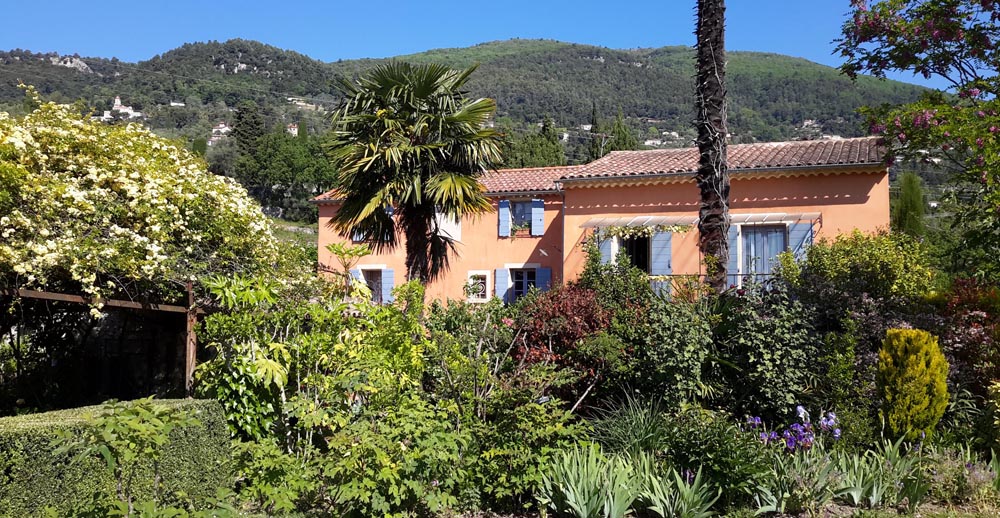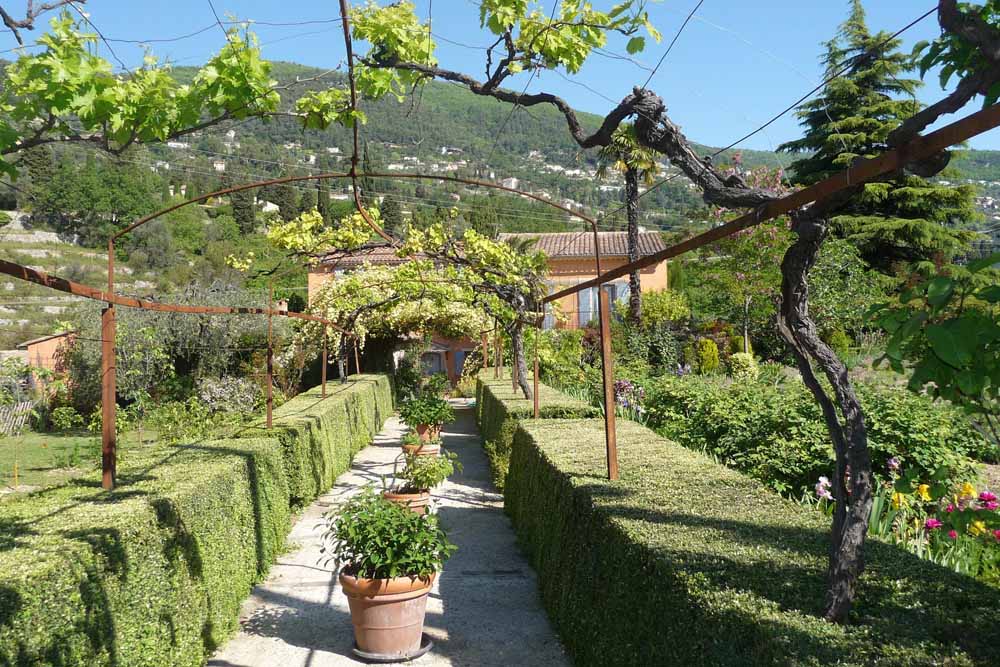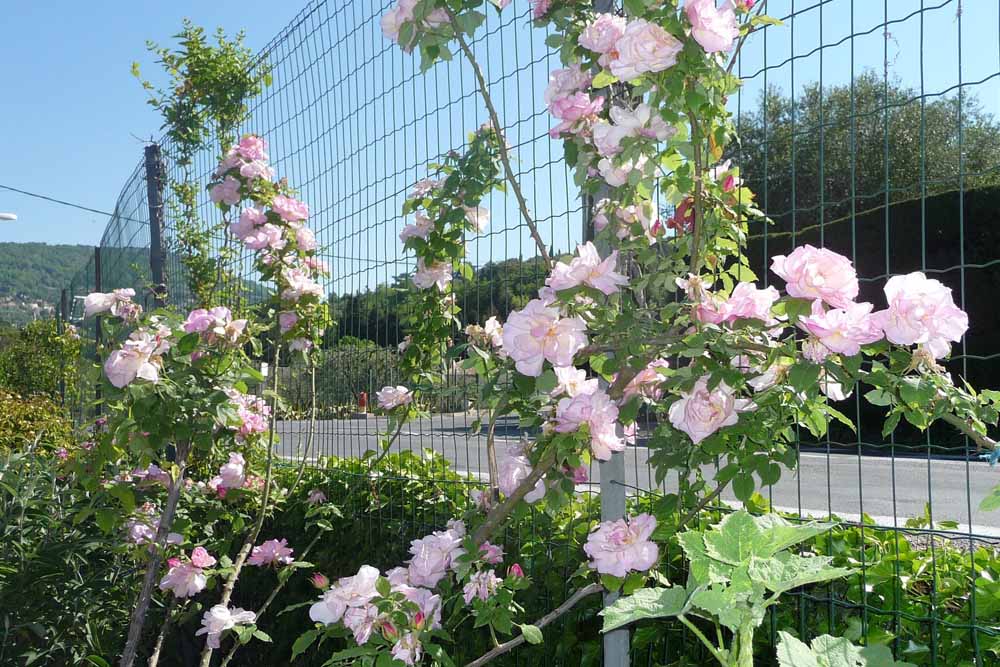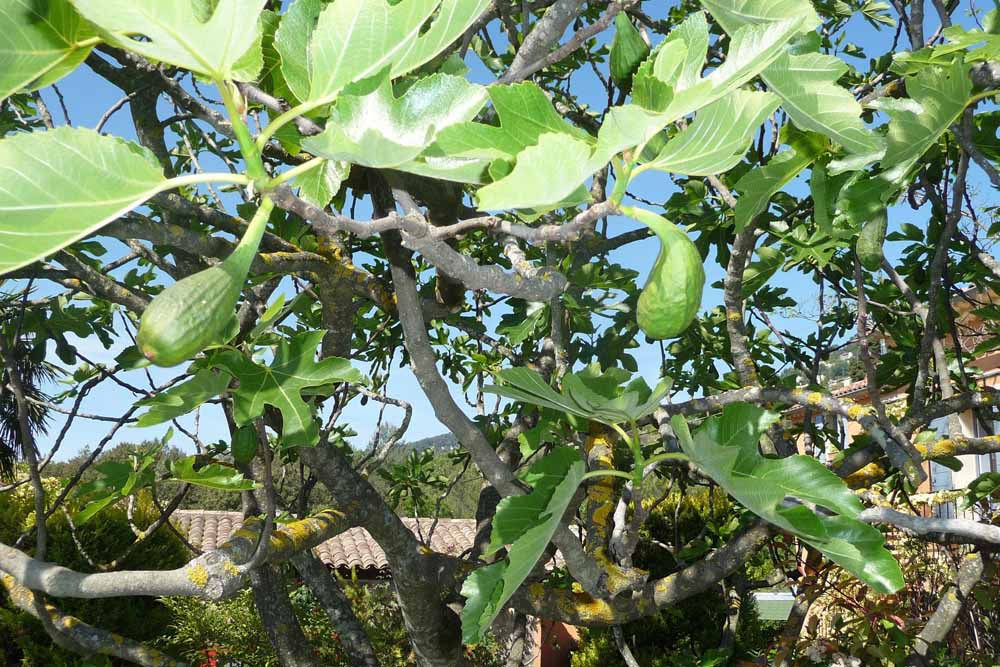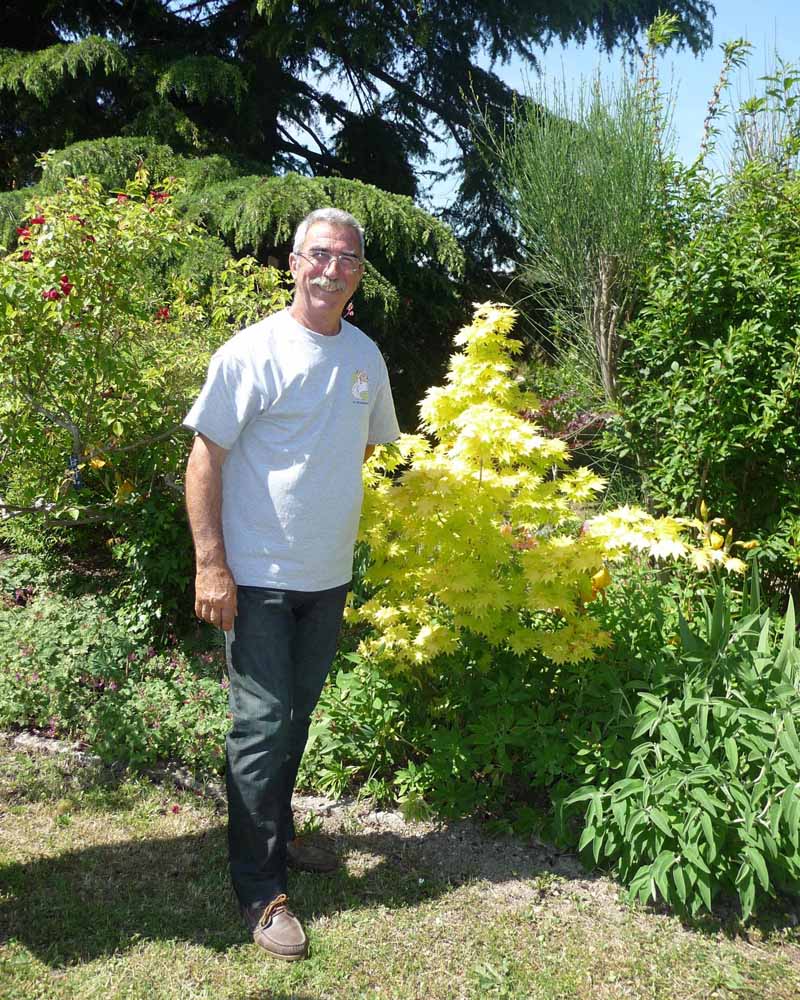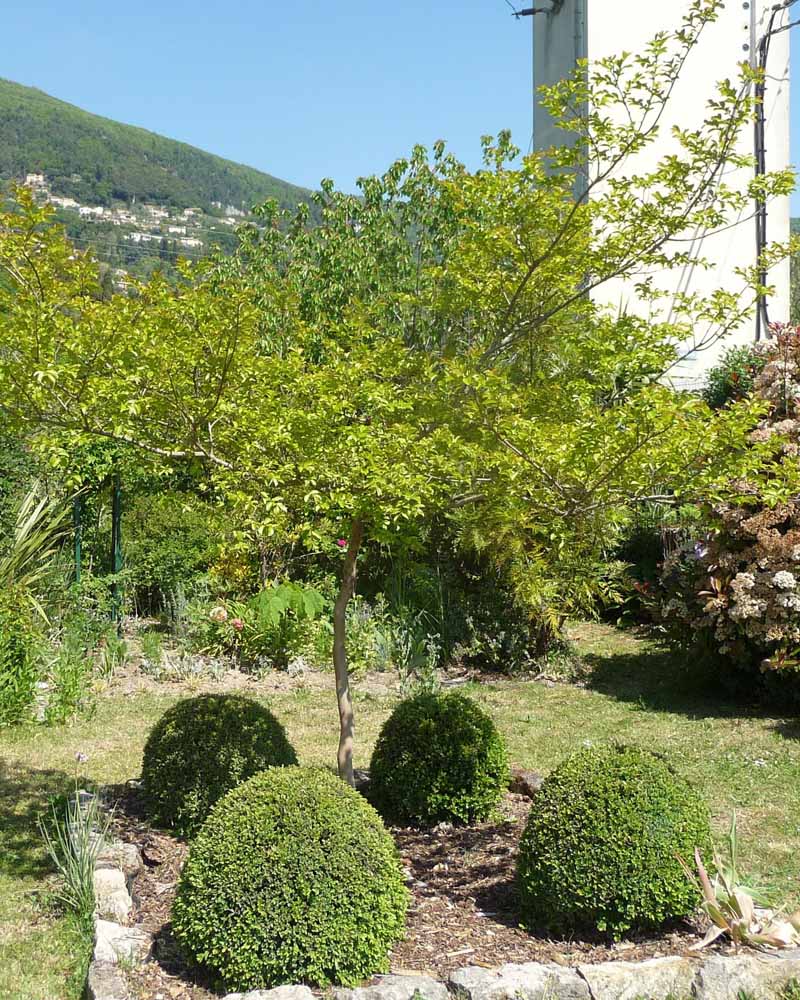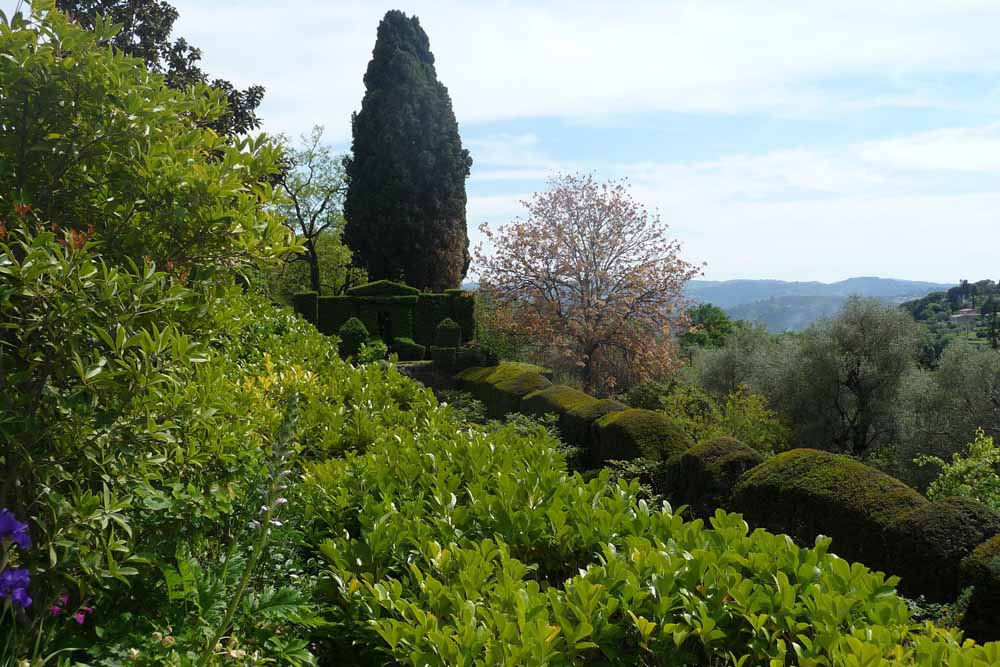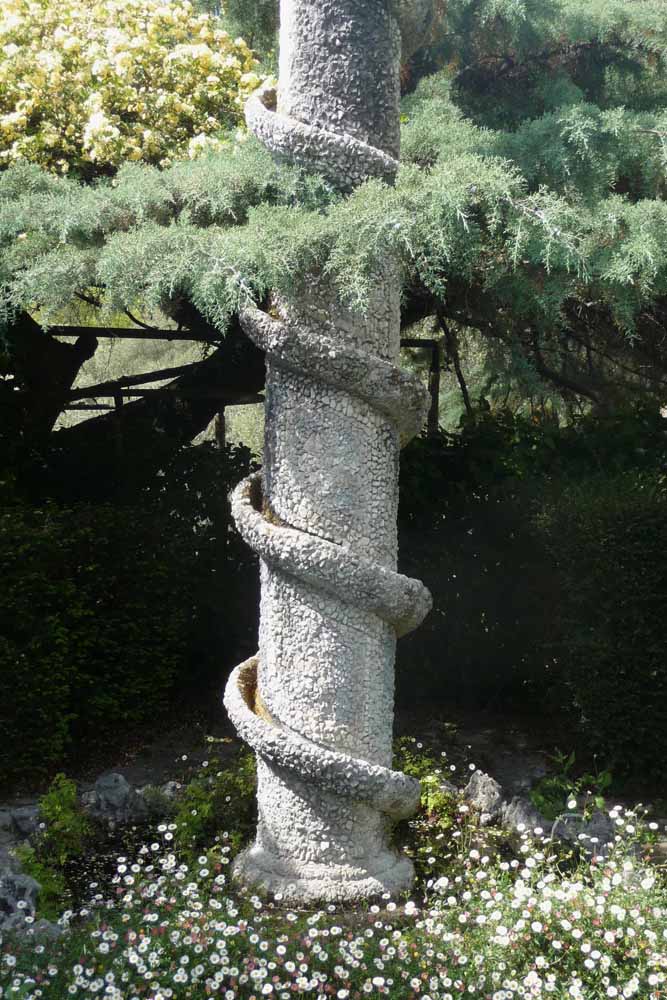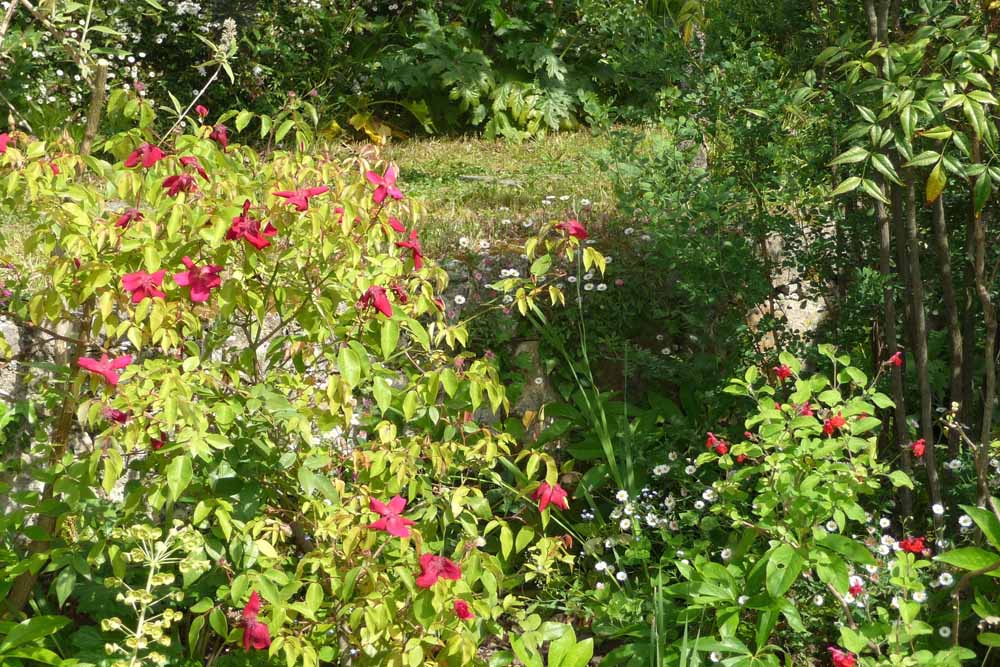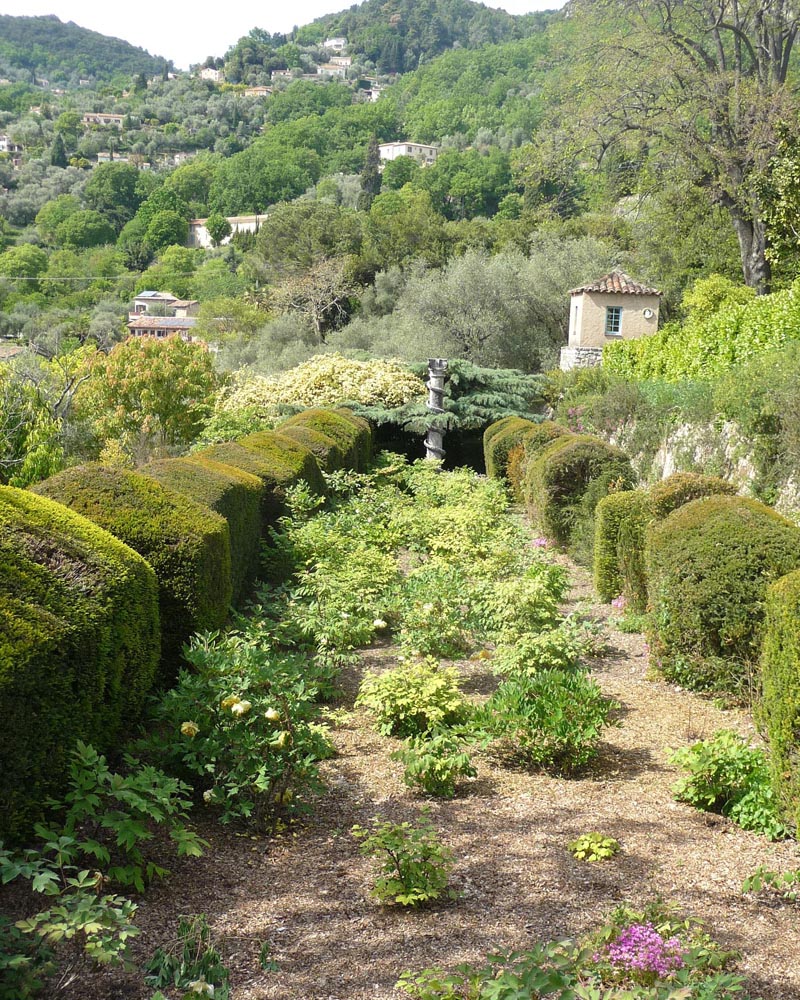May / mai 2016
A visit to Le Mas des Pivoines and the Villa Noailles, in Grasse
Click on an image to enlarge it / Cliquez sur une image pour l’agrandir
Le Mas des Pivoines is a lovely garden, which as Marcel and Lucile Barrault’s website rightly says, has all the charm of an old Grasse country garden with its arbours and its calade, a garden in constant evolution. 15,000 square metres in all, it has a substantial flat area around the house, then a steep descent down a few restanques to a field bordering a stream (dry in summer). They moved here 17 years ago, bringing seven lorry loads of plants – although, alas, unused to frost in their previous Grasse garden, they lost a huge number of them (six of the seven lorry loads, according to M. Barrault!) after the temperature dropped to – 8°C.
There is a great variety of herbaceous plants, roses, irises interesting shrubs and trees. In fact, Mme Barrault regrets that the garden was called Mas des Pivoines, as visitors come at a time when little else is in flower. Both are very keen gardeners, and both accompanied us round with many anecdotes and good descriptions. A gardening tradition goes back several generations. Sometimes they did not know the names of plants, as they had been inherited from Mme Barrault’s family – ‘cela vient de ma grand-mère, non je crois que c’était mon arrière-grand-mère’. They water sparingly.
An arbour with roses leads up to the traditional Provencal mas, with box hedges (there has been infection from blight, but it is kept under control with insecticide; all neighbours are quick to tip off others of further signs of the disease).
There are many peonies (e.g. Paeonia suffruticosa ‘Duchesse de Morny’, P. lactiflora ‘Félix Crousse’, a tree peony, P. ‘Spring Carnival’), although only one or two late ones in flower for us.
Among the many roses are Rosa ‘Excelsa’, R. ‘Clair Matin’, R. ‘Lady Waterlow’, R. ‘Etoile de Hollande’, R. ‘Arielle Dombasle’ and R. ‘Voile de la Mariée’, a number of which flower several times a year. Rosa ‘Lady Waterlow’, 1909, by M Nabonnand, a great rose grower of the ‘Midi’ is a little known rose according to Mme Barrault.
There are good iris de collection (each with a different perfume according to M Barrault), some from the nursery Iris en Provence in Hyeres and lots of buddleias, flowering at different times. We liked a carpet of brilliant yellow South African asters under a cedar tree, which needed no watering and could happily be trampled underfoot.
Among many small trees are an unusual fig tree with elongated fruits,
along with an avocado (bought grafted with replacement guarantee if infertile), Grevillea robusta, Gleditsia triacanthos, callicarpa, lilacs, lagerstroemias (lilas des Indes), a very yellow maple (rescued from a mauling in a rubbish truck and nursed back to life), Robinia ‘Idaho’, Cinnamomum camphora, Sorbaria sorbifolia ‘Sem’ and Corymbia ficifolia (previously known as Eucalyptus ficifolia, the red flowering gum).
There is a small citrus area, but it is necessary to wrap the trees in a double thick fleece in winter. A young kaki is fed with migon (sheep manure) once a month.
The garden still has the vestiges of its old irrigation systems in place, with water pumped from the well into open channels along the sides of the restanques to a small reservoir. M. Barrault found an old notebook giving the times and amounts of water each neighbour could use from this shared well – all apparently respected the watering hours.
The Barraults take part in local plant and seed exchanges, by troc with local gardeners and through an on-line grainotèque of which they spoke highly.
The garden has a sense of humour too. An amusing feature, encountered as we went down the steep steps, was a peaceful figure of a man and his spaniel, calmly fishing from the bassin and a Heath Robinson arrangement for drawing up water in an old watering can: on closer inspection, both man and dog were straw and clay models!
To conclude, a garden well worth visiting, either at peony time, or later.
Villa Noailles is a classic garden of the Provencal arrière-pays, built on steep restanques, using the existing stone, keeping the colours subdued, so the whole remains part of the landscape, without a jarring note. In this garden, the very subtle greys of the original (and added) stones, merge with the different but never obtrusive greens of the plants. Although there are also brightly-coloured flowering plants, there is a fantastic richness and depth of colour given by the deep greys and mature greens. The garden is extensive (three hectares), as the photo of the ‘monumental staircase’ running nearly the entire drop from top to bottom shows. Subtle as it is, like Nicole de Vésian’s ‘La Louve’ in the Luberon, the garden shows the hand of a near-genius designer. On every level, the stonework, steps, wall recesses with statues, clipped hedges and box are really works of art. The views of the surrounding hills are a superb backdrop.
The Vicomte Charles de Noailles bought the house and began work on the garden in 1947, after creating the other ‘Villa Noailles’ house and garden in Hyères, wanting a retreat from the coast. He lived there, working on the garden design, until he died, aged 89, in 1981. He chose a site with a good supply of water from springs. The garden was apparently open to the local inhabitants (as it is now, but very restricted hours, see below). The house is still owned by the family.
As to influences, comparisons are made to Lawrence Johnson’s designs (he and Vicomte Noailles were friends) and Hidcote, with its distinct garden rooms and use of sculpture. The garden’s prospectus refers to ‘inspiration anglaise et italienne’, and to ideas from the gardens of Villa Aldobrandini (the obelisk), and the Villa d’Este (the water wall inspired by the hundred fountains). There are numerous references to classical antiquity from the nymphaeum at the entrance onwards.
There is water, and the sound of running water – fountains, bassins, springs, rills along the paths – everywhere.
The plants:
The prospectus points out that this is a spring garden, with a myriad of perfumed plants. On our visit, there was a heady smell of jasmine and pittosporum throughout the upper garden. The plant varieties are listed as: tree peonies, Metasequoia glyptostroboides, a pergola of Judas trees, a field of deciduous magnolias and Japanese cherries, camellias, viburnum, hundred-year old box, acers, mahonias, Magnolia delavayi, olive trees, aesculus, osmanthus, sarcococca, roses, nymphaea, Scilla peruviana, amaryllis and many bulbs. One restanque is devoted to peonies.
There are also many simple plants, which are very effective. We liked the erigeron – sometimes on its own, in a beautiful stone pot, and round a low fountain. Again from the prospectus: “L’un des plus beaux effects du jardin est l’alternance de simplicité rustique et de raffinement géometrique” (a particularly beautiful effect is created by the contrast between rustic simplicity and refined geometric shapes).
The garden is looked after by one full time gardener only, with occasional extra help – a remarkable feat that she can keep it so well maintained. The address is:
59, avenue Guy de Maupassant, 06130 Grasse. Tel. 06 31 97 36 13.
Open from March to May on Wednesday afternoons from 1400 – 1700.
Footnotes:
1) Readers probably know that the Vicomte de Noailles co-authored a book ‘Plantes de jardins méditerranéens’ in 1977 with Roy Lancaster.1
2) One can only go into the entrance of the house, but don’t miss the beautiful 19th century tapestries of tulips, carnations and roses (in the loo).
1 Editor’s note: There is a copy of this book in the MGF library (catalogue number 287); to borrow it, email to Chantal Guiraud. There are also several second-hand copies available from on-line bookstores.
Text: Lesley Dean
Photographs: Lesley Dean and Nicola D’Annunzio
![]()

